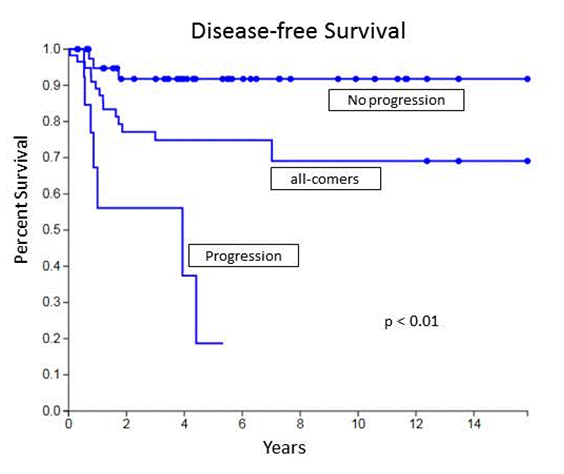Disease Progression on Neoadjuvant Chemotherapy Is a Strong Predictor of Recurrence for Pediatric Hepatoblastoma.
1Surgery, Baylor College of Medicine, Houston
2Surgery, Texas Children's Hospital, Houston
Meeting: 2017 American Transplant Congress
Abstract number: 75
Keywords: Immunosuppression, Liver transplantation, Pediatric
Session Information
Session Name: Concurrent Session: Pediatric Liver
Session Type: Concurrent Session
Date: Sunday, April 30, 2017
Session Time: 2:30pm-4:00pm
 Presentation Time: 2:30pm-2:42pm
Presentation Time: 2:30pm-2:42pm
Location: E271a
Purpose. In addition to peri-operative chemotherapy, proper triage between orthotopic liver transplantation (OLT) and partial hepatectomy (PH) is critical to limiting disease recurrence in pediatric hepatoblastoma (HB). Here, we present a large institutional experience with surgical treatment of HB.
Methods. All patients treated surgically for HB between 1998 and 2016 at our institution were considered. Primary outcomes were disease recurrence and disease-free survival. Risk factors for recurrence were assessed with univariate and multivariate analyses. Kaplan Meier survival was utilized for time-to-event analysis.
Results. 59 patients were included (20 OLT, 39 PH). Overall recurrence was 17% (20% for OLT, 15% for PH, p=0.6). Excluding salvage OLT, overall recurrence was 14% (10% OLT, 15% PH, p=0.6). Univariate analysis identified several risk factors for recurrence: progression of disease while on neoadjuvant chemotherapy (OR 13.7, p<0.01), lung metastases at the time of diagnosis (OR 7.2, p=0.01), and positive margin at the time of PH/OLT (OR 4.3, p=0.04). Multivariate analysis identified progression on neoadjuvant chemotherapy as an independent predictor of recurrence (OR 9.3, p=0.01). Overall 1-, 3-, and 5-year disease-free survival was 90, 78, and 78%, respectively. Compared to those with a favorable response to neoadjuvant therapy, disease-free survival was significantly worse for patients whose disease progressed (1-, 3-, and 5-year survival: 95, 93, and 93% vs. 55, 55, and 18%; p<0.01) 
Conclusions. In this series of surgically treated HB, recurrence rates were comparable between OLT and PH, indicating successful triage between the two modalities. A poor response to neoadjuvant chemotherapy was a strong independent predictor of disease recurrence. Regardless of surgical modality, patients whose tumors regressed during neoadjuvant treatment had excellent survival while those whose disease progressed had dismal disease-free survival. Protocols emphasizing the response to neoadjuvant chemotherapy should be the focus of future HB treatment groups.
CITATION INFORMATION: Kueht M, Commander S, Ha T.-A, Rana A, Shi Y, Vasudevan S, Goss J. Disease Progression on Neoadjuvant Chemotherapy Is a Strong Predictor of Recurrence for Pediatric Hepatoblastoma. Am J Transplant. 2017;17 (suppl 3).
To cite this abstract in AMA style:
Kueht M, Commander S, Ha T-A, Rana A, Shi Y, Vasudevan S, Goss J. Disease Progression on Neoadjuvant Chemotherapy Is a Strong Predictor of Recurrence for Pediatric Hepatoblastoma. [abstract]. Am J Transplant. 2017; 17 (suppl 3). https://atcmeetingabstracts.com/abstract/disease-progression-on-neoadjuvant-chemotherapy-is-a-strong-predictor-of-recurrence-for-pediatric-hepatoblastoma/. Accessed December 13, 2025.« Back to 2017 American Transplant Congress
